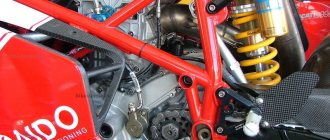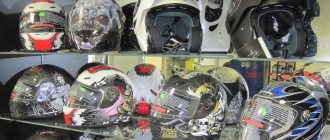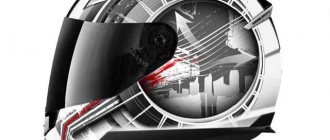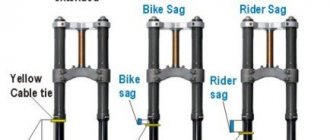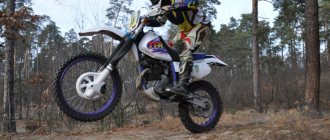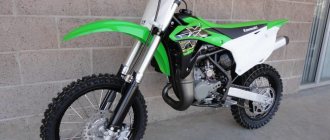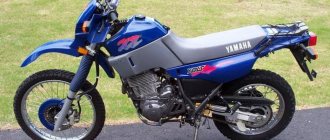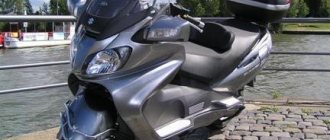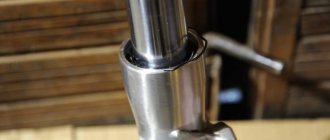In the rear suspension, it is easy to see both components: the spring and the shock absorber. Any road surface (yes, even fresh asphalt) has some unevenness. When driving over such uneven surfaces, the wheel may bounce and lose contact with the surface. When the wheel is not in contact with the road, it is not able to influence the trajectory of the motorcycle. In other words, the motorcycle becomes uncontrollable at these moments.
This phenomenon is partially smoothed out by the shock-absorbing properties of the tire itself. However, this is not enough. To more effectively combat unevenness, a suspension is used.
The main purpose of the suspension is to ensure constant high-quality contact of the wheel with the road surface.
The operation of the suspension has a significant impact on the contact patch of the wheel and, as a result, on the force of adhesion of the wheel to the road.
The suspension, as a rule, has two main parts: an elastic element (spring) and a damper (shock absorber).
Shock absorber
Any spring, if compressed and then released, begins to vibrate. The main task of a shock absorber in a suspension is to dampen (absorb) spring vibrations. The shock absorber converts the vibration energy of the spring into thermal energy (the fluid inside the shock absorber heats up, after which the heat is dissipated).
Properly selected and adjusted suspension components can significantly improve handling. At the same time, a faulty suspension can cause a sharp deterioration in the behavior of the motorcycle. The suspension must always be in good condition.
First steps to suspension
At the beginning of the 20th century, the creators of the first motorcycles realized the need to suspend the front wheel. And the need to use this system on the rear wheel arose later.
Motorcycle creators were preconceived that a soft rear suspension would worsen the motorcycle's handling.
In the past, designers tended to use thin pipes and flimsy joints. So, for a 500 cc motorcycle, 100 kg was considered normal weight, and accordingly, the rear wheel was moving. As the rear wheel moved, the chain tension changed. Due to the quality of steel of that time, chains broke quickly.
Shaft drive was even more complex, as the rear suspension required universal joints and (in some cases) a device to change the length of the shaft. The designers found a way out of this situation by suspending the saddle. Springs, which came from bicycle use, replaced designs with levers and coil springs. Harley abandoned springs on its heavy motorcycles only in the late 50s.
Suspension travel
In the front suspension - fork, the springs as well as the damping element are located inside the fork body.
During operation, the suspension is constantly compressed and unclenched, working out uneven surfaces. The travel of the suspension between the fully compressed and fully uncompressed states is called the travel stroke. The optimal operating mode of the suspension is achieved in the middle of its operating stroke. Towards the ends of the working stroke, the quality of the suspension deteriorates.
Also, the suspension can be compressed and unclenched under the influence of inertial forces acting on the motorcycle as it accelerates. When accelerating, the front and rear suspensions relax. When braking with the engine or rear brake, both suspensions are compressed. When braking with the front brake, the front suspension compresses and the rear suspension expands.
Front suspension
Good morning dear readers!
Today I propose to talk about such an important component of a motorcycle as the front suspension. We will look at the reasons for its appearance, the history of its creation, design and principles of operation, we will also look at the weak points of various design options and the subtleties that you need to pay attention to when riding, buying and repairing a motorcycle.
And so, as the motorcycle moves, vibrations and shocks occur. Due to the fact that any moving process is, first of all, the work of a dynamic system (dynamics, from the Greek δύναμις “strength, power”), which is always accompanied by various kinds of vibrations, pulsating, shock and cyclic loads. A motorcycle is no exception in this regard. The main source of vibration in the motorcycle itself is the engine, and the forces acting on the motorcycle are vibration and shock loads from the road surface.
We will talk in more detail about ways to eliminate these same loads that are transferred from the road to the motorcycle.
The most important responsibilities of the front suspension are:
— maintain the maximum possible area of the contact patch between the wheel and the road surface;
— ensure control of the front wheel, and therefore the vector of movement of the motorcycle as a whole.
In this article we will consider only the first point of this statement, because the second point relates to the dynamics of movement, and this is a topic for another article.
And so, let’s look at a typical case of a wheel hitting some abstract irregularity:
The process of absorbing irregularities itself is divided into two parts, the first part is the meeting of the wheel, (more precisely, the tire) with an obstacle at the very moment when the suspension has not yet begun to work due to the inertia of its own masses. And indeed, if we look at the graphical representation of the simulation of this process, we will see that at the moment the tire comes into contact with an obstacle, the tire itself, being literally an elastic body, is pressed through and softens the blow, firstly because the rubber itself is elastic, and secondly, because there is air inside it, and the air is under pressure. As you know, the graph of the compression force of any gas is progressive, but we will look into this feature of the physics of gaseous media in more detail a little later in this article. In the meantime, to summarize the first factor in the operation of the suspension - the primary damping of the impulse from unevenness on the road is taken over by the wheel tire and absorbs part of the energy, but at the same time transfers the remaining part of the energy to the suspension.
Let me make a small digression here and clarify a number of points: with all other things being equal, the magnitude of the parts of the impact energy, or rather their ratio, what the wheel absorbs and the residual energy transferred to the suspension, depends on the height of the wheel profile and the pressure in it. And also from the mass of the entire suspension as a whole, which is called a special term - “unsprung mass”. This is the mass of the wheel assembly with brake discs, cardan, axle and sprocket, if we are talking about the rear wheel, calipers and part of the suspension that is rigidly attached to the wheel.
Indeed, a high-profile wheel perfectly absorbs bumps in the road; a prime example of this is the chubby wheels of an ATV or swamp vehicle, which seem to flow around most obstacles lying in their path. Which gives a smooth ride, lack of vibrations and shocks. It also allows, for example, the latter to do without suspension at all; the soft wheel itself takes on the role of damping. But in our case, such a tire model is not suitable, because a motorcycle, unlike four-wheeled vehicles, has the ability to tilt when turning, and here the opposite requirement appears - rigidity, because if the wheel is soft, then the motorcycle will not the turn will not go in clearly. Therefore, the height of the wheel profile and its primary damping capabilities are still the same compromise between comfort when driving straight and when the motorcycle moves in corners.
The last nuance in this area is the difference in the properties of a high-profile and low-profile wheel. It rather depends on the type of motorcycle and its purpose. The same sportbikes have low-profile tires so that the driver can feel the motorcycle better when moving, especially in turns. But their rigid and short-travel suspensions are intended only for perfectly flat roads or sports tracks.
So, in fact, by analyzing the input data, we came to the heroine of our today's story - the front suspension of the motorcycle.
The development of this unit in the world of motorcycles was quite monotonous. The fact is that at the dawn of mass motorcycle construction, there were a lot of different designs of two-wheeled vehicles. For example, the front-wheel drive Megola motorcycle with a five-cylinder, star-shaped engine located in the front wheel. For these and many other devices, the classic front suspension, as you understand, was not suitable!
Until about the mid-40s, among heavy motorcycles (mainly with sidecars), various designs of lever and parallelogram suspensions were used, this was caused by the lack of comprehensive technologies for the manufacture of telescopic forks.
This flaw was completely eliminated around the beginning of the fifties, and since then the front suspension in the vast majority of cases has the classic look that is familiar to us.
Now let's look at the different types of front suspensions, their design and characteristics.
I’ll start, perhaps, with the very first front suspension, this is, of course, a springer with elastic elements and vibration dampers in the form of a pack of automotive-style springs or a double set of rebound/compression springs. The design of such a suspension was used on the very first motorcycles. It was technologically simple to manufacture, because it consisted entirely of metal (iron), which at the beginning of the twentieth century they had already learned very well to cast, forge, roll, bend and pull.
This suspension is still used today on motorcycles such as HarleyDavidson, and their imitators (for example, custom bikes). Only manufacturability, quality and performance characteristics have increased by several orders of magnitude since those long ago, but this is not surprising, after all, more than a hundred years have passed. This type of suspension has excellent driving characteristics, copes well with uneven roads and is considered very comfortable. In addition, this design gives the motorcycle a peculiar retro-style charm, which is especially important for classic styles such as chopper, cruiser and other imposing slow-moving vehicles.
Springer type pendants.
Next, we will look at the parallelogram suspension. This design and its variations are a small, tubular truss connected to the steering column by four short rocking arms. And a wheel is attached to it from below. Its first use was also dictated by a compromise between manufacturability and very tolerable driving performance, especially for heavy military motorcycles with sidecars and in off-road conditions. A later version of this scheme is Duolever from BMW, which appeared at the beginning of the 21st century and, for example, the front suspension on the Honda GoldWing 1800, 2021 model year. In fact, in the latest generations of this type of suspension, a cast, hollow aluminum fork is used instead of a tubular truss. Its advantages are low weight, rigidity and well-designed geometry, and its disadvantages are low repairability in the event of an accident.
Parallelogram suspension of various generations and designs.
The next type of suspension is lever.
It, in turn, is divided into long-lever and short-lever and, as well as pull-type and pusher-type suspension. The last two modifications differ from each other in the transfer of impulse from the wheel to the shock absorber; of all motorcycle designs, I have personally seen a pulling lever suspension only on the Honda NRX1800 ValkyrieRune. In general, such suspensions are as follows: on outriggers (stays), screwed on hinges the levers are placed at a certain angle, and shock absorbers or intermediate rods and a wheel are attached to them.
Unlike previous versions of suspensions, on a motorcycle with lever suspension, this was my first motorcycle - Ural-Tourist IMZ 8.103-40. Even despite its Soviet archaism, this device is very good in its driving performance, even in comparison with Japanese motorcycles of similar capacity and class. Having a front suspension of this design, the motorcycle had a smooth ride and very high ground clearance. Which gave me the opportunity to “endure” along country, forest and especially steppe roads, and at a very decent speed.
According to today's classification, the Ural-Tourist motorcycle is probably more of a scrambler.
This type of suspension is usually installed on heavy and off-road motorcycles, including motorcycles with a sidecar. These suspensions, as I have already described above, have excellent smoothness, even on a single ride, forgive collisions with all kinds of obstacles and have excellent torsional rigidity. The limitations of such suspensions are due to their rather expensive, stock production and inappropriate use for ordinary road motorcycles.
Suspension Ural-Tourist.
Short-link suspension of a rare Ural.
Traction suspension of the Honda Valkyrie Rune motorcycle.
Lever suspension, the so-called automobile type.
This suspension is perhaps the rarest in the motorcycle world. Much and quite contradictory information has been written about its dynamic properties. I will note that it absorbs road irregularities (especially small ones) best of all existing suspensions, and is even better suited, for example, for creating all-wheel drive motorcycles, but this is rather an experimental technique. Structurally, it can be cantilever (one-sided) or double-sided and is also divided according to the number of rods. Although it should be noted that motorcycles with such suspensions were mass-produced by Yamaha, and now they are produced by Bimota, its famous motorcycle is the BimotaTesi 2D and 3D. This is a very interesting sports bike, with a fantastic design and very powerful technical characteristics.
Tesi 3D
Yamaha GTS 1000
Concept from Ducati
A concept motorcycle with wishbone suspension and a 280 hp engine from Subaru.
Also, I would like to separately mention the proprietary BMW front suspension - Telelver
This is perhaps the most interesting hybrid of lever and telescopic suspension, combining the advantages of both designs. It has excellent torsional rigidity, handles road unevenness perfectly like a lever, and at the same time steers easily. In terms of design, it consists of two guide pipes attached to the upper cross-beam using spherical supports, and the lower cross-beam, in turn, connects the lower parts of the feathers to each other and the lever is attached to it. And the shock absorber, in turn, is attached to the lever.
The concept turned out to be very original, and, due to German pedantry, carefully worked out, and therefore very reliable.
The spatial-kinematic diagram shows that according to the nodal points (hinges) of the connection, the suspension is a combination of four triangles: right, left, front and bottom. And as we know, a triangle is the most stable and rigid figure.
Elastic/load-bearing suspension elements
There are only four such elements in the design: springs, leaf springs, torsion bars and air (gas).
Let's start with springs, as the most common parts of this group: springs in a motorcycle suspension are compression springs. The design of the springs is quite simple, but the manufacturing technology has its own difficulties. Also, the steel from which they are made is fundamentally different from any other in that it is, as it were, puff pastry. That is, layers of steel, in the manner of Damascus blades, are forged together, resulting in a layer-by-layer structure of the metal. This is necessary so that after special hardening the spring has the required elasticity, or, to use a professional term, metal memory arises, this is when the metal seems to remember its original shape and, after deformation, returns to it again.
Springs are divided according to the winding pattern (and compression work) into: conventional (linear), with variable winding pitch and variable winding diameter.
The last two versions have the most favorable compression characteristic, the so-called “progressive compression”, this is when the spring compresses much more easily at the beginning of compression than at the end. And the more it is compressed, the stronger the resistance. This makes it possible to have a smooth suspension and sufficient ease of handling most uneven road surfaces.
The springs shown in the figures above have a progressive winding; the coils with frequent winding or the so-called short coils are compressed first. They are responsible for handling small irregularities on the road, pebbles, and asphalt joints. The long coils come next, they take on a more serious load and are compressed by about 3/5 of the suspension travel. And the very last turns are conical, they work under the strongest shock loads, for example, when you drove into a hole that you didn’t notice.
Dynamics of spring compression under load. For example, a spring from a car is shown.
Next, let's look at the predecessors of springs - springs. Structurally, it is a set of steel sheets connected by a rivet or bolt. They are made of steel, similar to spring steel.
The rod/rod from the lever is mounted at the end of the longest plate; due to its length, it bends first, and then, depending on the increase in loads, the following plates are connected. Almost the same as in the case of springs.
And the last design in this direction is a torsion bar suspension. It is not used in modern motorcycles, but in the past it was used to suspend strollers or cargo tricycles.
Today, this technical solution is firmly established in the suspensions of off-road vehicles, some trucks and military equipment.
Structurally, it consists of a long steel rod (crowbar), forged from the same steel as the springs and leaf springs, which works to twist along the longitudinal axis.
And the last structure in this section is air.
Some motorcycles have air suspension. It looks something like this: instead of a spring there is a special cylinder into which air is pumped using a pump. Air, like any gas, has a progressive compression characteristic, yes, the gas is compressed like a spring and can hold a motorcycle. Such systems are used in military equipment, for example in tanks or in aviation, and all aircraft racks are designed precisely according to this principle. The system is also widely used in luxury business class cars.
This design is rarely used on motorcycles because it is too capricious. To operate, it requires the air shock absorber itself: an air pump, a filter, an air dryer, a pneumatic line, a control system with sensors, shut-off valves and a bunch of wires.
All this hardware often has physically nowhere to be placed on a motorcycle, and its weight and difficulty of maintenance are not even worth talking about.
The next element of the suspension is the impulse and vibration damper.
The purpose of this device in the suspension is due to the need to slow down the progress of the suspension and neutralize (dissipate) the energy received from unevenness on the road. The second duty of this device is to prevent the motorcycle from rocking due to the reciprocating action of springs, springs or compressed air.
The fact is that the listed devices have the nature of an oscillating body or self-damping oscillations. And after straightening, the spring will not calm down, but will continue to compress and expand for some time. This is what needs to be removed.
The first such vibration dampers were friction discs. They were pressed with special wing nuts. Their disadvantage was that they acted linearly, that is, they did not work with small impulses, and with large impulses of the suspension, received, for example, from a deep hole on the road, they failed.
Oil is another working fluid and a shock absorber (struts) - a suspension unit, the operation of which is based on the hydraulic resistance of flow from one cavity to another and back.
A standard oil damping device relies on a valve or drilling of a certain diameter in the bottom of the fork tube filled with oil. As the movable pipe moves upward, oil is forced to flow out through the valve or drilling into the pipe. As the moving pipe moves downwards, the oil resists the movement of the suspension. As a result, any tendency to rock the motorcycle is prevented.
For driver comfort, it is best if the wheel can move freely, reacting to uneven road surfaces. However, during downstroke, a damping effect is needed to improve handling. In addition, the amount of damping should depend on the compression and expansion rates of the fork. Various valves and orifices are used to ensure this during compression and expansion. When a certain maximum oil pressure is reached due to a high compression or expansion rate (from a strong impact or a deep pothole), additional valves are used.
And, also, the viscosity (thickness) of the oil plays a big role.
Depreciation is achieved through the use of a piston shock absorber or cartridge damper.
This is the design of the first (classic) suspensions; they worked quite well on motorcycles of the early, post-war generations. On domestic equipment they were installed on almost all models, all motorcycles. In addition, there may be wishbone suspensions and air suspension with air pumping - IZH Orion (not to be confused with air suspension with an air pump, these are different designs). Nowadays such suspensions, but from the next generations, are found on many modern motorcycles, mainly “choppers” and “classics”.
The next system that we will consider will be gas, say nitrogen, or air, the latter also consists of 75% nitrogen. These are already gas-oil shock absorbers.
The principle of operation is similar to pure oil shock absorbers, but here the main body is gas. During compression, oil is also distilled through the valves, but on the other hand it is supported by a piston, which in turn separates the gas and oil chambers. In the process of compressing the suspension, this piston, as an intermediary, transfers the impulse energy from the oil to the gas, and as I already said, gas, by its nature, has a progressive compression ratio. Plus, the high pressure in the gas cavity makes it possible to compress the oil, avoiding its cavitation boiling. And the ability to pump up or release pressure allows you to customize the suspension for a specific route or task.
And the latest generation of impulse braking systems with a hydraulic-pneumatic basis is a cartridge suspension with an electronic control system.
This pendant contains all the latest developments in its field. Such suspensions are used mainly on superbikes or on expensive, flagship sportbikes. Also on motorcycles competing in races and competitions like Paris-Dakar, AfricaEcoRace. At these events, various know-how is tested in order to later be released onto the civilian market. The parameters of such a suspension can be changed on the fly, which is called “from the button.” When the road situation changes, the pilot selects the desired suspension program and the latter begins to work as it was programmed for the given conditions.
There is another suspension impulse damping system that has recently left experimental laboratories. This is a fully controlled, electromagnetic system based on the properties of an electromagnetic fluid.
Structurally, it is a good old mono-tube shock absorber, but only made with the latest technology. Inside it there is a piston with built-in electromagnetic coils and wires connected to them. It also contains magnetic fluid, which is in fact a special machine oil with mixed ferromagnetic nanoparticles (special magnetic material). Various position, speed and pressure sensors are also built into this circuit.
When the suspension moves suddenly, the electronic system reads data from the sensors and gives a command to brake. This is done as follows: the microprocessor calculates in a split second the required voltage that must be applied to the electromagnetic coils inside the piston; when voltage is applied to the coils, an electromagnetic field appears, which controls the structure of the magnetic fluid, and therefore its viscosity. The system itself is quite interesting and many believe that it is the future.
Now the last part of my story about those suspensions that are installed on 99% of your motorcycles, these are telescopic suspensions of the classic and reverse type (the so-called “upside-down”).
From the previous part we found out a number of key parameters of the suspension: unsprung weight, suspension stroke and its energy intensity. Looking ahead, I will also add resistance to longitudinal torsion and bending.
Structurally, such a suspension is a telescopic structure, that is, a pipe within a pipe.
In turn, they are divided into two subtypes, as I wrote above, this is a classic design - in it, a smaller diameter pipe, usually made of steel, is clamped in the traverse.
And the “reversal” is when a larger diameter pipe is clamped in the traverses; it is mainly made of light aluminum alloy and, on the most powerful racing motorcycles, of Kevlar.
The classic suspension has one undoubted advantage: safety in a frontal impact. In other words, it bends and thereby dampens the impact. Which very often helps to keep the pilot’s hands intact and save them from fractures. Here is a typical example of suspension flex during a frontal collision with an obstacle.
The suspension bent backward until the wheel hit the engine.
Such suspensions are installed mainly on choppers, classics and medium-sized road cars. In other words, for equipment that is not required to perform delicately on the road.
To increase torsional rigidity and bending resistance, they usually increase the diameter of the supporting pipes - stays; the largest, as far as I know, are from Harley-Davidson - something around 53 or 55 mm in diameter.
Inverters have all the other advantages: rigidity for all bending and torsional loads, stability during collisions, wider options for settings due to more advanced filling. Excellent tracking of road irregularities, very precise, measured control of the motorcycle. Another important factor is the feedback from the motorcycle to the pilot; it accurately conveys all the nuances of the bike’s movement, which allows you to win fractions of a second on the race track, and therefore, prizes.
This type of suspension is also used on motorcycles of the following classes: cross-country, enduro and, my favorite, heavy tourenduros. This is where it is simply necessary, with its ability to clearly hold the road, reduced inertial masses of a small-diameter moving pipe and at the same time very large wheel strokes. Which is mutually exclusive for a conventional suspension due to the required length and the ratio of length to diameter in the traverses.
The diagram below shows the proportion of the feathers that are clamped into the traverse relative to the length of the entire pendant.
Essentially, it turns out the following: let’s take the ratio of the length of both types of pendants to the diameter of their fixed part – 600/40=15 and 600/60=10. If we translate it into a more understandable language, then the length/diameter proportions of the shifter, judging by the numbers, are one and a half times higher.
And therefore, the ability to withstand all the above loads.
Or, in other words, the shorter the stick, the more difficult it is to break (bend), the same principle works here. And indeed, take for example a match or a toothpick and try to first break it into two parts, then break these parts in half. On the third attempt, it will be problematic to do this with bare hands. Because the length/diameter ratio will be closer to the second type of suspension.
One physics and nothing but physics!!!
And in addition, I would add a little more about the inverted type suspension, that is, about the “upside-down”: since a larger diameter pipe is clamped into the traverse, and there is nothing restricting it from the outside, the shape of the pipe itself can be made, for example, at an incline, or speaking in very simple words, it turns out to be a triangle. Yes, yes, you understood correctly - a triangle of rigidity is obtained, which further increases the load-bearing capacity of this (my favorite) type of suspension!
But that’s not all. This type of suspension allows you to make traverses of greater height, which significantly increases the coverage area of the feathers, and this, in turn, increases all of the above characteristics!
Compression and rebound characteristics
All suspensions essentially work in such a way as to soften the impact of road unevenness, but at the same time so that the wheel does not lose contact with the road. This is the compression/rebound characteristic, and the suspensions work according to these two parameters. All of the above tricks are related to combining necessary but opposing requirements.
This diagram shows how the suspension works in compression and rebound.
Let us explain the formation of the hydraulic characteristics of the shock absorber:
•If all the valves are “tightly” closed, and the passage of hydraulic fluid occurs only through the bypass channel in the piston, you will get an absolutely rigid linear characteristic - line 1. These were the first shock absorbers and friction plates.
•If you turn on the valves communicating with the gas chamber, the characteristic will become “softer” - line 2. The asymmetry is explained by the fact that the valve opening on “compression” has a larger flow area than the valve operating on “rebound”.
•If you use the main valves located in the piston, the shape of the characteristic is no longer linear and, as the valves open and the total flow area of the channels increases, it becomes less and less “rigid” - line 3.
Actually, red line No. 3 is a progressive characteristic that best handles all the unevenness of the road surface. This is achieved by controlled valves, progression patterns and progressive coil springs.
In this graph, these curves are precisely an expression of the operation of the suspension and its settings depending on the required conditions.
Ivan Rukovitsyn for Motozastava
- List of articles
- Motorcycle service
- Winter storage
- Contacts
Suspension and lean angle of the motorcycle
As the angle of the motorcycle increases, the performance of the suspension deteriorates. This is caused by the fact that the suspension elements begin to work not perpendicular to the road surface, but at an angle. In this regard, the grip of the tires on the road also deteriorates as the angle of inclination of the motorcycle increases.
It is with this phenomenon that the driving technique known as “hanging over” is associated. By hanging from the motorcycle towards the inside of the turn, the rider allows the motorcycle to be more upright. As a result, the suspension works better and the tires are in better contact with the road.
Sprung tail
The German company NSU and the American Indian began producing motorcycles with a “sprung tail” in 1913. The Germans began to use a design that would later be called Cantilever - a triangular pendulum, its upper apex resting on springs located under the saddle. The Americans use a simple pendulum; vertical struts extend from the wheel axis, connected at the top to leaf springs.
The Indian company subsequently returns to the “hard” option, rejecting innovation. At this time, their ideas were picked up by the British, and Cantilever systems appeared on motorcycles of the 20-30s Brough Superior, Matcheless, HRD-Vinset. Leaf spring suspension is used by Granville Bradshaw on his famous ABC boxer.
In addition to the fact that the British develop ideas borrowed from others, they also generated their own. The OEC company custom installed rear suspension on its motorcycles (the pendulum is connected to a spring hidden in a vertical casing). Coventry engineers proposed a rear suspension similar to that of cars - semi-elliptical springs with the wheel axle mounted in the middle part.
At this time, the Italians were not far behind. In 1928, the Moto Guzzi GT debuted with an original rear suspension (a triangular pendulum, connected at the top to the frame, with a lower angle through long rods acting on a package of coil springs located under the engine).
Another Italian company, Gilera, chose a different method in the 30s - suspension (the pendulum is connected to an intermediate lever acting on horizontal extension springs).
On the Altea motorcycle, engineers used a system with a single spring strut connected to the swingarm near the swing axis.
More about motorcycle suspension springs
I present a translation of a detailed article about motorcycle suspension springs. Before reading, it would be a good idea to study the previous article.
Perhaps you have heard of progressive springs? It sounds good! My point is, who doesn't want to be progressive? And how long will ordinary motorcyclists be sold on conventional, conservative springs?
Before we talk about the advantages and disadvantages, we should find out what they even are and make it easier with the help of graphs. Many have already forgotten what it is, but I will try not to bore you.
Myths and misconceptions about motorcycle suspensions.
Translation of another article about suspensions, which contains almost all (even the most stupid) myths and misconceptions about motorcycle suspensions, collected by the authors, based on the most frequently asked questions in ProMechA. The article will be of interest, first of all, to owners of road bikes and sports bikes.
— Is it true that a “maintenance-free” shock absorber is really maintenance-free? — Over the years of working with various suspensions, we have never been able to find a maintenance-free shock absorber. Another issue is the cost of such service. Most modern shock absorbers (let's say from the late 1980s) can be rebuilt and serviced. The most expensive repair of shock absorbers is restoring the chrome coating and tidying up the appearance.
— Can I “drive” his pendant from a friend? — Each motorcyclist has his own riding style, his own characteristics of cornering, not to mention weight. When setting up the suspension, specialists pay attention to all these factors, so it is best to customize the suspension of your motorcycle to suit you.
— Does spring preload increase its stiffness? — Spring preload increases or decreases seat height, but DOES NOT AFFECT spring stiffness. If anyone talks about stiffness increasing with preload, they simply have no idea what they are talking about. The shock absorber spring should compress almost completely and then return to its original state without any change in length. When you "preload" a spring, you are simply tightening it. If your spring has a spring rate of 1 N/mm and you give it 15 mm of preload, that means you are transferring 25 Nm of force to it. initially. In order for the spring to work, you will first have to overcome this force, and then the spring will work normally, based on its initial stiffness. The fact that the spring starts working at a force of not 10 Nm, but 15 Nm, for example, gives a false feeling of increased rigidity.
— Should I use different suspension settings for everyday driving and for track driving? — Suspension adjustments are designed to change the riding characteristics of the motorcycle, depending on the riding style. City settings allow you to achieve comfortable daily driving in any conditions, including rain. Such settings are not suitable for the track, when the main goal is sharp cornering, intense braking, etc. And in order to cover as wide a range of riding conditions as possible with the same motorcycle suspension setting, it is adjusted specifically for the rider.
— Will tuning shock absorbers help tune the suspension better? — You must decide what level of customization is sufficient for you. Even simply replacing the spring on the rear shock will give you better road feel and also improve acceleration times due to the more predictable effect of the rear suspension sagging at the start. Compared to any stock shock absorber, a tuned version will provide significant advantages when riding a motorcycle.
— My suspension works better when a passenger is sitting on the motorcycle. — Usually people say that the suspension works better when it is not loaded, but it happens that the shock absorber spring does not match the weight of the rider, and handles bumps too harshly. The passenger's weight further tightens the spring and gives a false feeling of softness. It is enough to decide on your driving style (city, track, touring) and select a spring with the appropriate stiffness for this style.
— Does nitriding have any significant effect? — No, there is no noticeable effect on slippery surfaces. This also means that you won't be able to repair a stone chip because the surface can't be polished as well as chrome.
— Can I pour brake fluid into the fork legs of a motorcycle? - NO! The chemical composition of shock absorber seals is designed to work exclusively with oil. In addition, fork oil has a number of additives that help maintain a certain viscosity over different temperature ranges, as well as additives that counteract foaming. For the same reason, motor oil should not be used in shock absorbers.
— The steering wheel turns too easily and behaves unstably when steering. Do I need a steering damper? — The rear shock absorber has the greatest influence on steering stability. At the start, it sag too much and, unloading the fork, gives the steering wheel a wobble. The steering damper is designed to control the front wheel and prevent it from oscillating from side to side. As a rough example, imagine a racing motorcycle that slightly overshoots the track with its front wheel while cornering. The wheel encounters an unevenness in a turn and begins to live its own life. So, a steering damper is needed in order to stabilize the front wheel of a motorcycle in such situations. With the correct selection of elements and proper suspension settings, for most road and not very track-oriented sports motorcycles, a steering damper is not needed.
— Is the rear wheel UNLOADED during acceleration? - Yes, but not always. When accelerating, the wheel begins to move relative to the road surface, and the road pushes the lower part of the wheel forward (and vice versa - Newton's 3rd Law). As a result, the motorcycle accelerates. If you look at a motorcycle's swingarm, you will see that it receives forward motion from the rear wheel axle. Thus, when the wheel moves the axle forward, it acts on the pendulum, pushing it upward. It’s very simple to check these words - just burn the rubber by holding the front brake and sharply releasing the clutch while the gas is open. The motorcycle fork will load and the tail will rise. When the rear brake is applied, the tail, on the contrary, will lower, since the vector of force acting on the rear brake caliper will pull the pendulum to the ground. In this case, two more factors must be taken into account: 1. When accelerating, the motorcycle tries to fall back, requiring additional efforts from the suspension to resist. The suspension compresses, it sag, the pendulum changes its position relative to the ground. Depending on how high the motorcycle's center of gravity is and depending on the angle of the swingarm to the ground, either the rear wheel will be unloaded or loaded. This is why riders adjust the angle of the pendulum, depending on the effect they want to achieve. 2. If you are in the middle of a turn, or going uphill, the rear suspension is already loaded and the swingarm angle to the ground will be quite sharp. Thus, when you open the throttle mid-corner, the tail of the motorcycle will sag rather than rise. This is why racing motorcycles often have stiffer, less progressive springs.
Shock absorbers and nitriding
Another old myth is maintenance-free shock absorbers. There are no such things, the only question is the price of service. There are different suspensions, modern models of shock absorbers for them most often require modification, but they require maintenance to one degree or another. As practice shows, the most expensive repairs of shock absorbers include restoration of their appearance.
You need to understand that driving in the city and on the track require different suspension settings. You are not satisfied with the basic shock absorbers - you can tune them, but often it is enough to replace the spring and the effect is immediately felt. An important point: if the suspension works clearly better when there is also a passenger on the motorcycle in addition to the driver, then the spring is too stiff.
T.N. Nitriding, contrary to popular belief, will not help at all on slippery surfaces. Even worse, it is not polished perfectly: it will not be possible to remove chips from stones.
How a Motorcycle Works: Front Wheel Suspension
The telescopic fork rules! No other solution compares to it. Countless attempts to replace it with something else have so far ended in fiasco.
The telescopic fork (even in the upside-down version) is not ideal. When braking, the fork dives, which is basically not beneficial (do you remember the anti-dive systems of Suzuki, Kawasaki or Honda?). Well yes, but when the front end is lowered, the rear end is raised, causing forward travel in the sportsbike example to drop from 100mm to about 75mm and the angle between the fork and the ground to decrease from 66 to 70°, i.e. the fork approaches vertical. Because it is installed on the head of the frame, located at an angle, and at the moment of sagging, the wheel moves not only up, but also backward. For this reason, the wheelbase is reduced from 1450 to 1405 mm. Typically, during the braking phase, the geometry of the motorcycle changes to something more favorable for portability.
